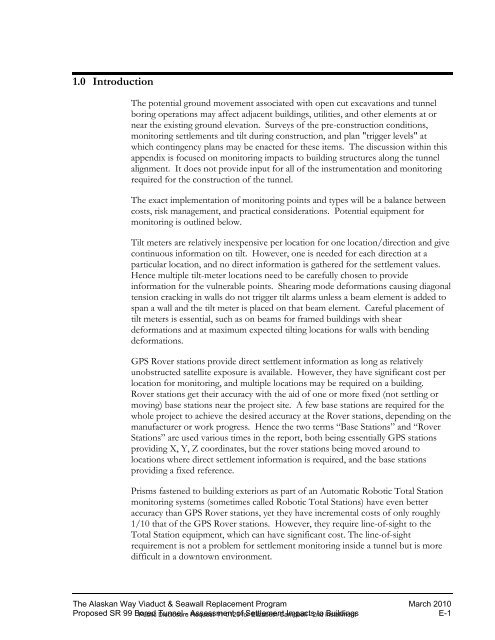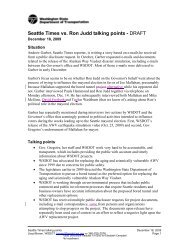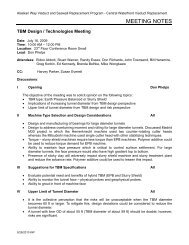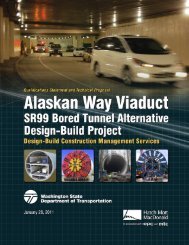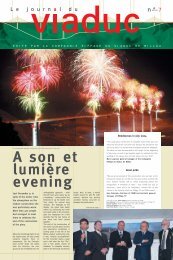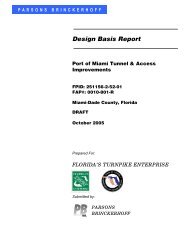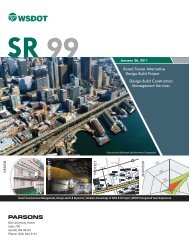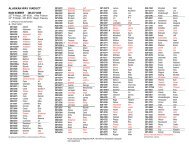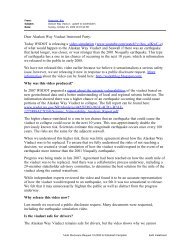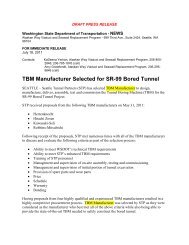SR99 Bored Tunnel-Assessment of Settlement Impacts ... - SCATnow
SR99 Bored Tunnel-Assessment of Settlement Impacts ... - SCATnow
SR99 Bored Tunnel-Assessment of Settlement Impacts ... - SCATnow
Create successful ePaper yourself
Turn your PDF publications into a flip-book with our unique Google optimized e-Paper software.
1.0 IntroductionThe potential ground movement associated with open cut excavations and tunnelboring operations may affect adjacent buildings, utilities, and other elements at ornear the existing ground elevation. Surveys <strong>of</strong> the pre-construction conditions,monitoring settlements and tilt during construction, and plan "trigger levels" atwhich contingency plans may be enacted for these items. The discussion within thisappendix is focused on monitoring impacts to building structures along the tunnelalignment. It does not provide input for all <strong>of</strong> the instrumentation and monitoringrequired for the construction <strong>of</strong> the tunnel.The exact implementation <strong>of</strong> monitoring points and types will be a balance betweencosts, risk management, and practical considerations. Potential equipment formonitoring is outlined below.Tilt meters are relatively inexpensive per location for one location/direction and givecontinuous information on tilt. However, one is needed for each direction at aparticular location, and no direct information is gathered for the settlement values.Hence multiple tilt-meter locations need to be carefully chosen to provideinformation for the vulnerable points. Shearing mode deformations causing diagonaltension cracking in walls do not trigger tilt alarms unless a beam element is added tospan a wall and the tilt meter is placed on that beam element. Careful placement <strong>of</strong>tilt meters is essential, such as on beams for framed buildings with sheardeformations and at maximum expected tilting locations for walls with bendingdeformations.GPS Rover stations provide direct settlement information as long as relativelyunobstructed satellite exposure is available. However, they have significant cost perlocation for monitoring, and multiple locations may be required on a building.Rover stations get their accuracy with the aid <strong>of</strong> one or more fixed (not settling ormoving) base stations near the project site. A few base stations are required for thewhole project to achieve the desired accuracy at the Rover stations, depending on themanufacturer or work progress. Hence the two terms “Base Stations” and “RoverStations” are used various times in the report, both being essentially GPS stationsproviding X, Y, Z coordinates, but the rover stations being moved around tolocations where direct settlement information is required, and the base stationsproviding a fixed reference.Prisms fastened to building exteriors as part <strong>of</strong> an Automatic Robotic Total Stationmonitoring systems (sometimes called Robotic Total Stations) have even betteraccuracy than GPS Rover stations, yet they have incremental costs <strong>of</strong> only roughly1/10 that <strong>of</strong> the GPS Rover stations. However, they require line-<strong>of</strong>-sight to theTotal Station equipment, which can have significant cost. The line-<strong>of</strong>-sightrequirement is not a problem for settlement monitoring inside a tunnel but is moredifficult in a downtown environment.The Alaskan Way Viaduct & Seawall Replacement Program March 2010Proposed SR 99 <strong>Bored</strong> <strong>Tunnel</strong> - <strong>Assessment</strong> <strong>of</strong> <strong>Settlement</strong> <strong>Impacts</strong> to Buildings E-1Public Disclosure Request 11-0123 for Elizabeth Campbell - 2nd installment


